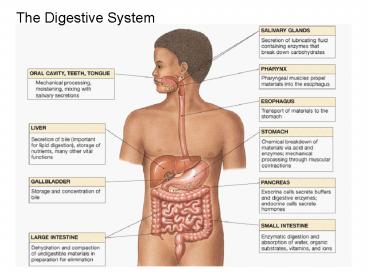The Digestive System PowerPoint PPT Presentation
1 / 38
Title: The Digestive System
1
The Digestive System
2
Digestive Processes
- Ingestion taking food into mouth.
- Propulsion movement through alimentary canal
(swallowing, peristalsis).
- Mechanical Digestion Physical breakdown of food
(chewing, churning).
3
- Chemical Digestion Enzymatic breakdown of food
(from complex to simple building blocks).
- Absorption transport of digested products from
lumen of G.I. tract to blood and lymph (inside
body).
- Defecation elimination of indigestable and
waste products from body (feces).
4
(No Transcript)
5
(No Transcript)
6
Salivary Glands Intrinsic (inside oral cavity)
e.g., lips cheeks.
Extrinsic (outside oral cavity)
Mumps
1) Parotid (largest) - a serous gland.
2) Submandibular - a serous gland.
3) Sublingual (smallest) - a mucus gland
- Lingual amylase (breaks down starch).
- Lysozyme antibacterial agent in saliva.
7
(No Transcript)
8
- Esophagus
- Muscular tube, 10 inches long.
Transition from skeletal to smooth muscle.
(hence voluntary to involuntary)
Mucous glands in tela submucosa (layer) to
lubricate bolus.
Outermost layer is Adventitia or Serosa.
outside peritoneal cavity
inside peritoneal cavity
9
(No Transcript)
10
- Stomach acidic (pH 2) storage of chyme.
- Mechanical Digestion continued (churning).
Has 3 muscle layers, for churning.
- Enzymatic Digestion of proteins occurs here
(Pepsin breaksdown proteins).
- Only Absorption of alcohol and aspirin.
- Rugae allows for expansion when volume of
contents increase.
11
?
?
?
12
Production and secretion of gastric juices
controlled by CNS.
e.g., Vagus nerve
Parietal cells make Hydrocholic acid (HCl) in
gastric glands.
Chief cells make Pepsinogen, which is cleaved to
pepsin (?HCl), to digest proteins.
13
Small Intestine
Duodenum
Jejunum
Ileum
Increase Surface Area for Absorption
1) Plicae Circulares
2) Villi (Intestinal)
3) Microvilli
Lacteals absorption lipids
Intestinal glands Goblet cells Stem cells
14
The Small Intestine
15
Villi of Small Intestine
Vascular Arcade (from superior mesenteric a.)
Mesentery Proper - is a double layered serous
membrane attached to the small intestine.
Roles - Supports branches of blood vessels. -
Supports lymphatics of the jejunum and ileum. -
Supports nerves of the jejunum and ileum.
16
- The distinguishing features of each region of the
small intestine.
17
The Large Intestine
Begins as pouch inferior to end of ileum Ends at
anus.
Functions of Large Intestine
1) Reabsorb water and compact feces.
2) Absorb vitamins (helps make Vit K)
electrolytes.
3) Stores fecal matter.
- The Cecum
- Contains the Ileocecal valve and connected to
appendix.
The Colon Ascending, Transverse,
Descending, Sigmoid.
18
(No Transcript)
19
The Colon
- Lack of villi
- Abundance of goblet cells
- Abundance of mucous-secreting intestinal glands
20
The Rectum and Anus
21
The Liver
22
(No Transcript)
23
- Diagrammatic view of lobular organization.
24
(No Transcript)
25
(No Transcript)
26
(No Transcript)
27
(No Transcript)
28
Histology of the G.I. Tract
29
1. Tunica Mucosa
A Mucous membrane 1) Epithelium 2) Lamina
propria 3) Muscularis mucosae
2. Tela Submucosa
Areolar Connective Tissue
Submucosal Plexus for Nervous innervation
30
3. Tunica Muscularis Externa
Smooth muscle layers
1) Inner Circular Layer 2) Outer Longitudinal
Layer
Myenteric Plexus
4. Tunica Serosa (or Adventitia)
Serous membrane aka visceral peritoneum
- Name depends on location
- Inside peritoneal cavity serosa
- Outside peritoneal cavity adventitia
31
Tunica Mucosae
- Lines digestive tract
- Moistened by glandular secretions
- Simple or stratified depending on area of tract
- Pleated for expansion (Surface Area)
32
The Peritoneum Two layers Visceral
peritoneum (a.k.a. serosa) Parietal peritoneum -
Lines inner surfaces of body wall
Mesenteries Fused double sheets of peritoneal
membrane to suspend portions of digestive tract
e.g.
Greater omentum Lesser omentum Mesentery
proper Transverse mesentery Sigmoid mesocolon
33
- Retroperitoneal Structures these are attached
to posterior abdominal wall.
e.g.
- Most of the Duodenum
- Ascending colon - Descending colon
- Pancreas
34
(No Transcript)
35
(No Transcript)
36
- Horizontal section through the upper abdomen
showing the position of the liver relative to
other visceral organs.
37
Muscularis Mucosae
- Smooth muscle layer capable of plasticity
- Ability to tolerate stretching
- Visceral smooth muscle
- Cells arranges in sheets
- No motor innervation
- Pace setter cells cause waves of contraction
38
(No Transcript)

